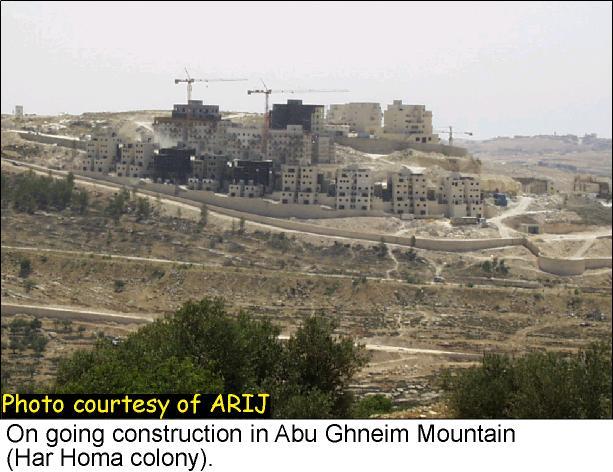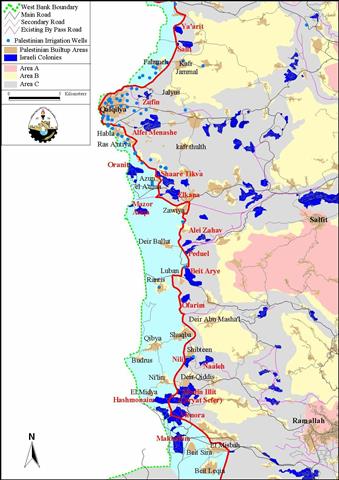The several members of the Israeli government have in recent weeks claimed that it will refrain from establishing new Jewish (settlements) or expropriating more land for their expansion. But, even if adhered to, this trick hides the fact that colonies are already scattered in every corner of the West Bank and have enough expropriated land already to ensure room for continued rapid settlement growth for years to come; The Israeli authorities will have their hands full just keeping up with building for the construction plans they have already issued. This case study examines two large building plans approved in March, 2001 in the area the Israeli's call ''Greater Jerusalem,'' which they plan to formally annex to Israel in a future ''final status'' agreement with the Palestinians; see map.
Har Homa settlement
On 16th March 2001, the Israeli housing ministry announced the approval of the second stage of building work on Jabal Abu Ghneim. The plans include the addition of a further 2,800 housing units to the current 2,200 units that make up the new Har Homa settlement. Reports stated that so far only 600 housing units have been sold, with a marked drop in interest since the start of the Al Aqsa Intifada; see photo.
Israeli building work on Abu Ghneim Mountain was largely responsible for the breakdown in Israeli-Palestinian negotiations in 1997. This new settlement received international condemnation for going against the spirit of the Oslo Agreement. It has widely been seen as a tactical move to hinder Palestinian claims on East Jerusalem and as such it must been understood as a serious obstacle to peace. By approving the second stage plans at this point, the Israelis re-emphasize their determination to maintain control of the area. Many people might have hoped that the Israeli authorities should have realized the impossibility of retaining this location, in order that the Palestinians could form a viable state on a contiguous piece of land; see map..
Instead, on 22nd March, Israeli Prime Minister Sharon expressed his commitment to this settlement in a discussion with UN secretary-general Kofi Annan saying, ''The decision 10 years ago to build the neighborhood in Har Homa flowed from the need to prevent a contiguous Palestinian connection between Bethlehem and Beit Sahur, and Sur Baher and other neighborhoods.'' He explained that this desire to prevent the two Palestinian built-up areas touching stemmed from the aim to draw the border of an Israeli Jerusalem through this region. He noted that, ''Once the two [areas] touch, there will be no possibility of drawing a border.'' Though 'a border' should be understood as the Israeli's idea of a suitable border. Any border drawn through Abu Ghneim would of course separate Bethlehem from East Jerusalem and as such would be unable to provide the basis for a viable Palestinian state.
Gavaot settlement
On March 23rd 2001, Haaretz newspaper published an article stating that the Israeli Housing Ministry issued a master plan for the construction of a new Jewish (settlement) in the West Bank that will be called Gavaot. As a matter of fact, the location was a military training camp for the Israeli army established in 1984; the plan is to transform it into a residential area. The new (old) settlement, which is planned to hold 6,000 new settlement-housing units, is located south of Jerusalem, in the Gush Etzion Block, between Betar Illit and Allon Shevut settlements. According to the plan, Gavaot settlement will be located south of Betar Illit settlement, which is inhabited by Ultra-Orthodox settlers; see map 2.
The master plan was proposed under the government of the former PM Ehud Barak and was acceded by the Israeli Civil Administration. The Ministry plans to offer a detailed project proposal for the building of 2,000 housing units in Gavaot settlement as a first stage, which they hope to be accepted in the near future. Official sources from the Housing Ministry reported that Gavaot settlement is designed for the accommodation of the national-religious public see photo..
The village of Nahhalin, on whose land Gavaot is being built, is one of the Palestinian agricultural villages in Bethlehem District. It is located 20 kilometers southwest of Bethlehem City and has a population of about 4,700. Nahhalin is neighbored by a number of West Bank villages (such as Husan and Wadi Fuqin) whose economy also depends mainly on agriculture.
The Israeli colonization activities in Nahhalin village started as early as 1967. Presently, several large Jewish settlements encircle Nahhalin village. Betar Illit settlement lies to the north of the village, while to the south it is surrounded by other settlements of the Gush Etzion Block, which has been in place since 1967. This settlement block includes Rosh Zurim agricultural settlement, Neve Daniyyel settlement, and the new settlement of Gavaot, a former military outpost. Jewish settlements encircling Nahhalin village
|
Jewish settlement |
Establishment Date |
Settlement Type |
Population |
Area (dunums) |
|
Betar Illit |
1989 |
Urban |
11,300 |
3,145 |
|
Neve Daniyyel |
1982 |
Urban |
780 |
426 |
|
Rosh Zurim |
1969 |
Agricultural |
299 |
892 |
|
Gavaot |
1984 |
Urban |
128 |
90 |
|
Allon Shevut |
1971 |
Urban |
1,980 |
705 |
|
Kfar Etzion |
1967 |
Agricultural |
450 |
857 |
Source: ARIJ Database, 2000.
The settlements have taken up about 20% of the village's best agricultural lands. Approximately 5,689 dunums of Nahhalin village have been confiscated for the construction of these settlements. The justification used by the Israeli authorities for this order was that it was ''state-owned land.''
The expansion of Gavaot settlement will link this settlement with the nearby Jewish settlements, thereby leading to the construction of a belt of settlements that will surround Nahhalin village. Such construction will result in the loss of large stretches of Palestinian agricultural land and threaten the village with annexation to Israel. see photo.
In conclusion, the intention of the Israeli government to build 2,800 new housing units in Har Homa and 6,000 in Gavaot reflects its continuing policy of colonial expansion. This purpose is also reflected in data released by MK Mussi Raz (Meretz party) in a Haaretz article on February 26, 2001. Raz pointed out that in year 2000, the Israeli government began the construction of 1,943 new housing units in the Palestinian Territories, which is the largest number in any year since 1992. The figures illustrate that in the final quarter of 2000, construction work started on 954 housing units, up from 368 in the last quarter of 1999. Clearly, the ''peace process'' did not halt colonial activity. In fact, the rate of colonization increased as Israel enjoyed the world's false impression that it was in the process of returning the lands it took in the 1967 war. The Palestinians have no reason to believe that negotiations will bring a higher level of integrity and good will from Israel now.
Prepared by:
The Applied Research Institute – Jerusalem




















